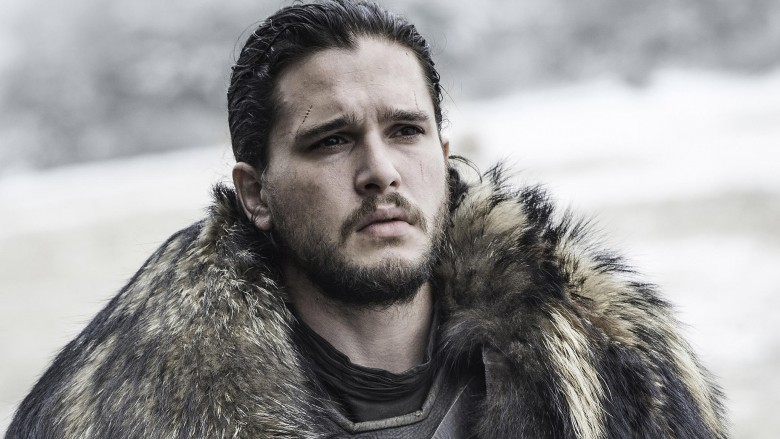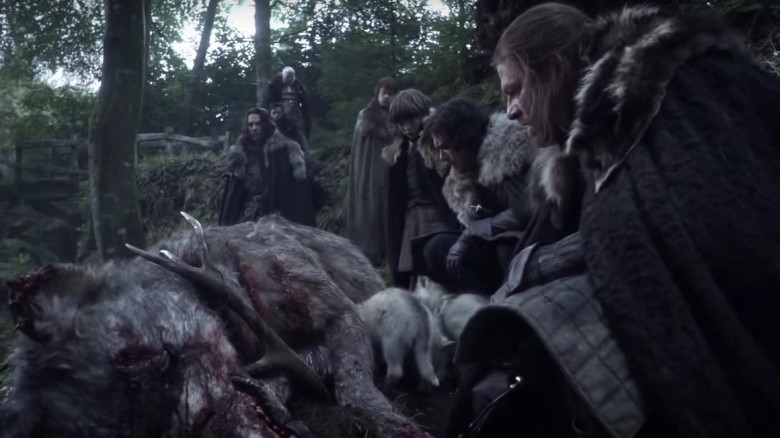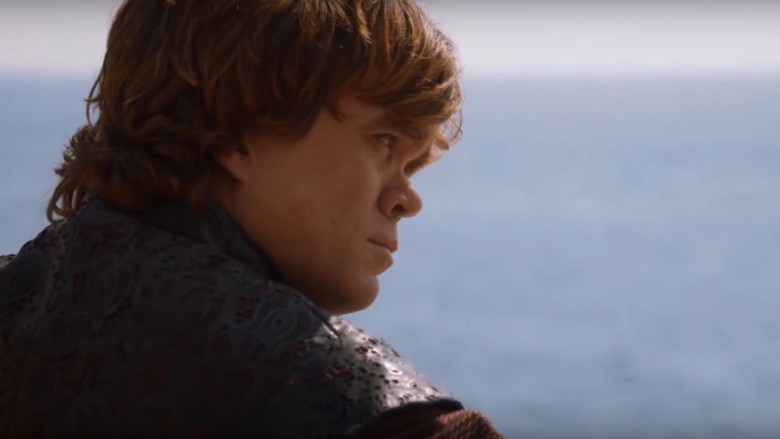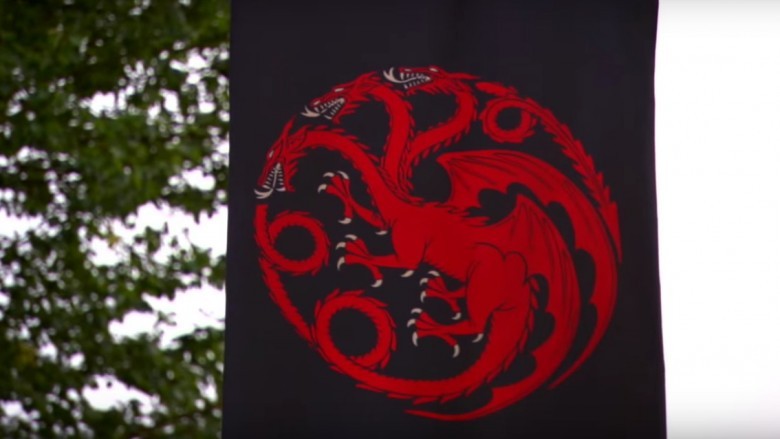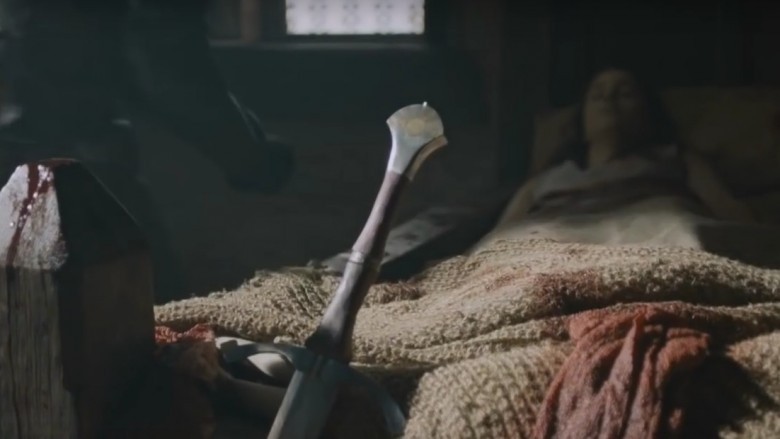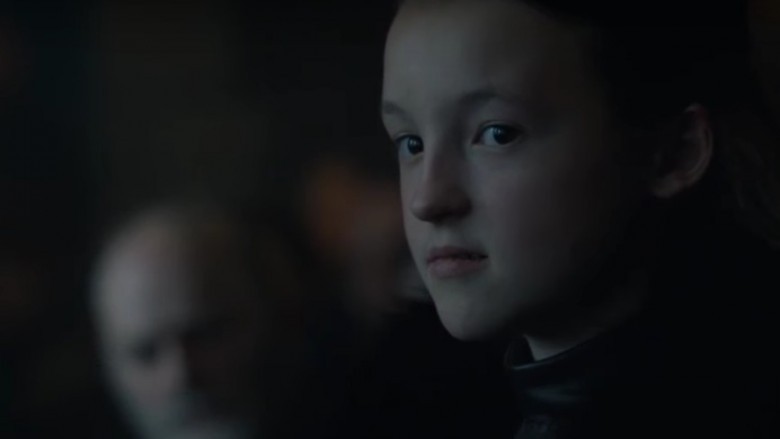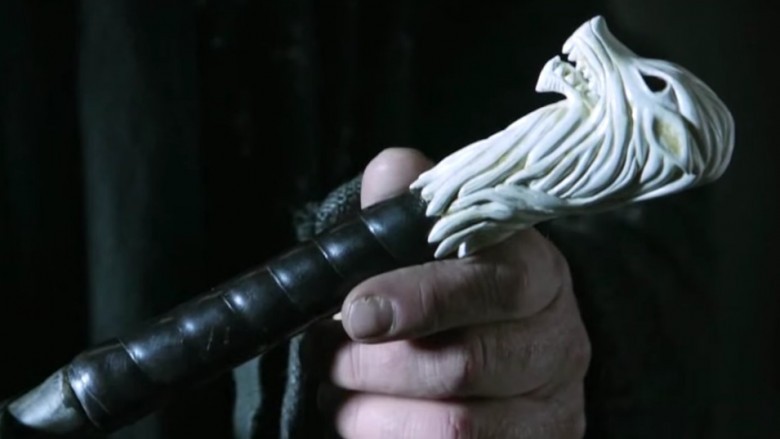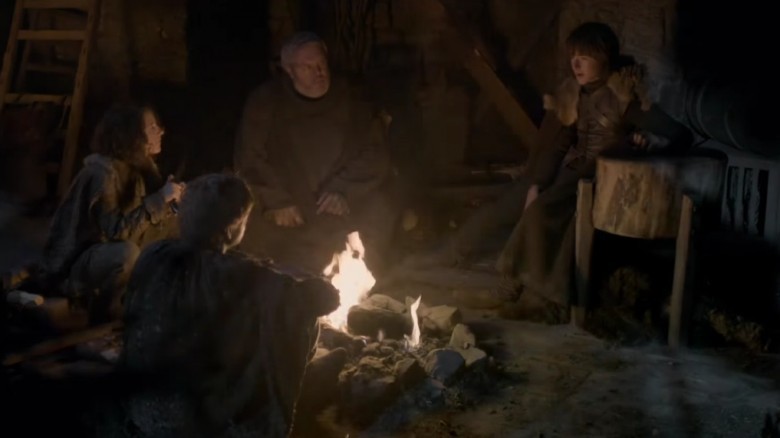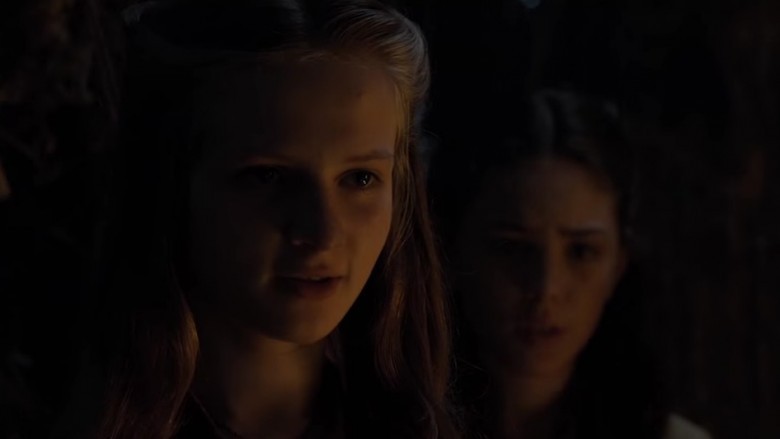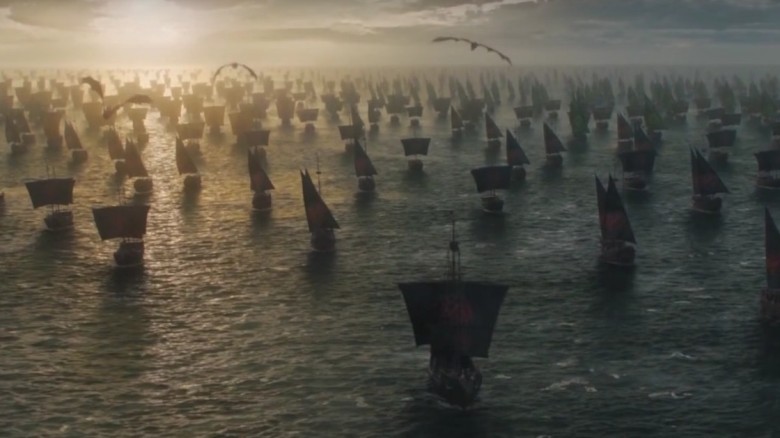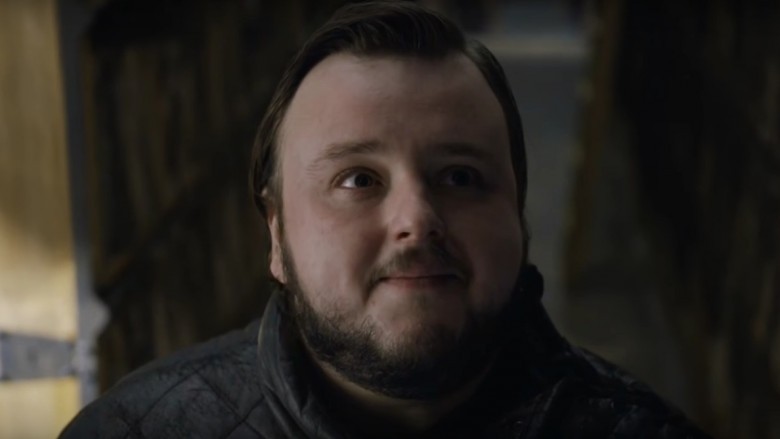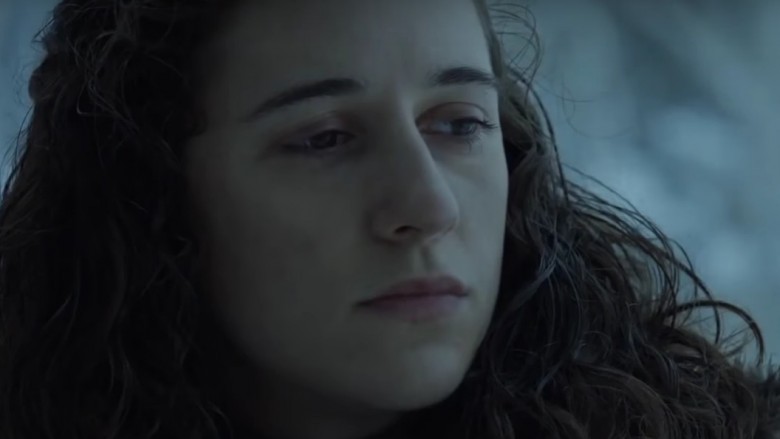Critical Game Of Thrones Plot Points You May Have Missed
Winter may no longer be coming, but much-anticipated news about the return of HBO's Game of Thrones certainly is. The wait for the show's eighth and final season feels like being stuck in the Long Night. So until then, take a look at these critical plot points you may have missed in the seasons leading up to that sure-to-be-epic final run. Before you continue, however, be warned: this article is dark and full of spoilers, and those who read only George R.R. Martin's books would be wise to come back after having watched everything that has thus far transpired in Westeros and across the Narrow Sea.
A slaughtered direwolf foreshadowed Ned Stark's death
Let's start with likely the most easily noticeable piece of foreshadowing in the entire series. Anyone who's rewatched the first episode of Game of Thrones, "Winter is Coming," may have noticed that the dead direwolf stumbled upon by Eddard Stark and his family was a predictor of Ned's death. As the direwolf is the sigil of House Stark, it is evident that the slaughtered animal, along with its six orphaned puppies, symbolized the sad fate of Ned and his six—well, technically five—children. Further reinforcing the foreshadowing is the fact that the deceased direwolf was gored by a stag, the sigil of then-king Robert Baratheon.
If only Ned hadn't been such a damn loyal friend, the show might still be graced with actor Sean Bean's presence.
Tyrion could totally be a Targaryen
Recount, if you will, the number of times you recall hearing Tywin Lannister tell Tyrion "you're no son of mine." It pretty much occurred, in some fashion, every time the father and son spoke to each other. Most viewers might dismiss this as Tywin verbalizing his hatred toward the child whose birth was responsible for his wife's death, or just being plain mean. However, what happens if we take Tywin literally?
In the first episode of Season 3, "Valar Dohaeris," Tywin dismisses Tyrion's assertion that he, as the eldest eligible son, should inherit the Lannisters' ancestral stronghold of Casterly Rock. "You are an ill-made, spiteful little creature full of envy, lust, and low cunning. Men's laws give you the right to bear my name and display my colors, since I cannot prove that you are not mine," he retorts. "And to teach me humility, the gods have condemned me to watch you waddle about wearing that proud lion that was my father's sigil and his father's before him. But neither gods nor men will ever compel me to let you turn Casterly Rock into your whorehouse. Go, now. Speak no more of your rights to Casterly Rock. Go!"
Why would Tywin, who places family above all else, so adamantly refuse his own flesh and blood his lawful right to inherit Casterly Rock? Because, dear reader, Tyrion may not be a Lannister after all.
There is a plethora of evidence to back up the theory that Tyrion is not a Lannister, aside from Tywin's own repeated insistence. For one, Tyrion is obsessed with dragons, and mentions that he has been since childhood. Secondly, the last time we see Tyrion, he's allied with the one person who controls dragons: Daenerys Targaryen. Furthermore, he's described in the A Song of Ice and Fire book series as having pale blonde hair—possibly resulting from a mixture of the Lannister golden blonde with the Targaryen silver—and mismatched eyes, which is purported to signify Targaryen inbreeding.
And, on top of all that...
The dragon has three heads
Everyone's favorite Queen of Mereen, Khaleesi of the Great Grass Sea, Lady Regnant of the Seven Kingdoms, Protector of the Realm, Unburnt, Breaker of Chains, Queen of the Andals, the Roynar and the First Men, and Mother of Dragons does, in fact, have more than one dragon—as the plural form of "dragon" in Daenerys Targaryen's excessively long title accurately signifies.
But does Dany really need three? It's only physically possible for her to ride one, which makes us wonder: who will ride the other two? If Dany's prophetic dream sequence in the book series is to be believed—in which Dany's slain brother Rhaegar claims "the dragon has three heads"—there must be other Targaryens. (Because, you know, Daenerys only has one head.) So, we naturally must ask: "Who are the other heads?"
Answer: Tyrion Lannister and Jon Snow.
If Tyrion is in fact half Targaryen, then it's completely plausible that he could at least control, if not mount, one of Dany's reptilian children. This is made more feasible by the fact that Tyrion is one of the series' most important and least dead characters, potentially inferring his long-term importance to the plot.
And while we're on the subject of not-dead, potential Targaryens...
Jon Snow is probably the Prince that was Promised
We know Stannis Baratheon isn't "the Prince that was Promised," because, for one, he's dead. (Or is he?) Aside from that, Melisandre herself tells Jon, after bringing him back to life in the third episode of Season 6, "Oathbreaker": "The Lord let you come back for a reason. Stannis was not the Prince Who Was Promised, but someone has to be."
That someone is Jon Snow.
By now we know Jon isn't actually the bastard son of Ned Stark, but rather the son of Ned's dead sister, Lyanna. According to the prophecy, the Prince that was Promised would be born under a bleeding star. Commonly thought to be the burning meteor from the first season, the bleeding star in question was probably Arthur Dayne, the dual-wielding Targaryen Kingsguard we saw defeated by a young Ned Stark and Howland Reed at the Tower of Joy. The symbol of House Dayne is, in fact, a shooting star, which is strategically displayed on the pommel of Arthur's sword as Ned places it against the foot of Lyanna's bed—all of this causing little baby Jon to be born, symbolically, "under a bleeding star."
But why would the most honorable man in the Seven Kingdoms promise to pretend, for the rest of his life, that Jon was his bastard? Simple. We can infer from the presence of two Targaryen Kingsguard at Jon's birthplace that the babe is the offspring of Lyanna and Rhaegar Targaryen. (You know, all that R+L=J stuff.) With Ned being on the side of his good buddy Robert Baratheon—who, by the way, had just slayed Rhaegar on the battlefield—Ned couldn't exactly hand over his own sister's half-Targaryen baby to the Seven Kingdom's most prolific Targaryen killer, could he? Add to that drama the fact that Robert was madly in love with Lyanna, and you have yourself one juicy Westerosi love triangle.
Speaking of Jon and Lyanna...
Jon Snow was proclaimed King in the North by another Lyanna
In "The Broken Man"—the seventh episode of the sixth season—we're formally introduced to the young and fierce Lady Lyanna Mormont. Bella Ramsey's character is indeed named after (you guessed it!) Jon's mother, Lyanna Stark. And wouldn't you know it, only moments after Lyanna Stark confirms that R plus L does, in fact, equal J, we see Lyanna Mormont proclaim her namesake's son King in the North. Coincidence? We think not! Whether this clever plot device leads directly to more cleverness in Season 7 remains to be seen, but something tells us we haven't seen the last of little Lady Lyanna.
And Jon's connection to the Mormonts doesn't end there!
Jon Snow's sword once belonged to Jorah Mormont
You know Jon Snow's sweet "bastard" sword, with the rad direwolf-head pommel and ultra-rare Valyrian steel blade? It was actually the ancestral blade of House Mormont. As we learned way back in the ninth episode of the first season ("Baelor"), Longclaw—as the sword is known—was passed down by Lord Commander Mormont to Jorah Mormont, before Jorah brought disgrace upon the family and was exiled (as we learn in the books) by Ned Stark.
Cleverly, the same episode in which we see Jon gifted the Mormont's ancestral sword is the same in which we see Ned's head severed from his body by the Starks' ancestral Valyrian sword—named Ice. Because Ice no longer exists, having been melted down and forged into two swords in the first episode of the fourth season (titled... well... "Two Swords"), that would make Jon's the new ancestral sword of House Stark. This clever and easily missable plot point further deepens the relationship between House Stark and House Mormont.
Let's just hope Jon doesn't get his head cut off by his own sword, shall we? Oh, and by the way... Jorah's sword hand isn't infected, so the day may come when he wields Longclaw again.
Arya Stark's revenge was inspired by the Rat Cook
Arya Stark's brutal method of crossing Walder Frey's name off her hit list—serving him a pie stuffed with his sons' flesh before slitting his throat—was hardcore. It wasn't, however, particularly original.
You may recall, back in the tenth episode of the third season, Arya's brother, Bran Stark, telling his travelling companions the story of the Rat Cook. According to the legend, when a king of old visited the Night's Watch, the cook murdered the king's son, baked him into a pie and served him to the king (who, by the way, wanted seconds). As punishment, the gods turned the cook into a fat rat who could only survive by eating his own young.
Most importantly, the cook received this punishment not for murder, nor for feeding the king is son, but for breaking the laws of hospitality by killing another under the protection of his own roof—easily one of the most heinous of crimes in the eyes of the gods. Sound familiar? Of course it does.
Everyone remembers the Red Wedding as the time when Robb Stark was betrayed—and when he, his wife, his unborn child, his mother and his entire army were slaughtered beneath the roof of Walder Frey at the Twins. What many viewers may have missed is that this brutal event wasn't simply shocking in terms of the series' plot, but also an atrocious affront to the gods—one which would not go unpunished.
Walder Frey literally got his just desserts when Arya gave him a taste of the Rat Cook's medicine...or pie, rather.
Cersei Lannister is destined to be killed by a brother
In the fifth episode of the fifth season, "The Wars to Come," we learn about the time Cersei Lannister visited a witch in the woods outside Casterly Rock. The witch foretold to Cersei that she would marry not a prince but a king, and that she would have three children, all of whom would all wear golden crowns before ultimately wearing golden shrouds. Furthermore, the witch told Cersei that she would be cast down by a younger, more beautiful queen.
We've already seen the first two parts of this prophecy come true. Cersei was to be wed to Rhaegar Targaryen—a prince—but ended up marrying the man who killed him, King Robert Baratheon. After Robert's death, Cersei's three children all, at some point, wear a crown. They also all, at some point, die, leaving us only the prophecy's last part yet to be fulfilled: that someone younger and more beautiful would cast her down. (*cough* Daenerys! *cough*)
But wait! Fans of the books know HBO elected to omit the prophecy's crucial ending. In A Feast for Crows, the witch finishes by stating "And when your tears have drowned you, the valonqar shall wrap his hands about your pale white throat and choke the life from you." The word "valonqar" is—believe it or not—the High Valyrian word for "little brother," and we can all but guarantee that this part of the prophecy will also come true.
The only real mystery here is which brother will do the choking? Will Tyrion Lannister get his revenge for years of abuse, or will the Kingslayer, Jamie Lannister, become a Queenslayer?
Our money's on Tyrion.
Dany is seriously sailing squad deep
Did you catch that entourage Khaleesi is rolling up to Westeros with?
The last time we saw Daenerys, the Unburnt had quite the army sailing with her. In case you weren't looking closely, here's a quick rundown of who's got Dany's back.
First and foremost, she's got Tyrion, who we already know might be half-Targaryen, and who we definitely know is a shrewd and powerful ally. The self-proclaimed rightful heir to the Iron Throne also has the Tyrells, Martells, and Greyjoys at her disposal, as we can see their sails proudly displayed alongside the Targaryen fleet. Further bolstering her lineup is the Unsullied and the Dothraki, both sure to give the knights of Westeros a run for their money. Finally, she's with the character who could potentially have been pulling the strings from the very beginning: Lord Varys the eunuch (who can really cover a lot of ground in a seemingly short amount of time).
Oh yeah, and she has dragons, which are essentially weapons of mass destruction in high fantasy terms. Three, to be exact. Winter has finally come, but the Seven Kingdoms is about to get hot.
Samwell Tarly might be telling the story
You probably noticed that the giant gyroscopes hanging inside the Citadel are the exact ones we've seen in the opening credits for years now—decked out with the sigils of all the great houses. More than just a clever playing of the long game, the fact that the gyroscopes audiences are so used to seeing are actually located where Samwell Tarley will be studying hints that, maybe, Sam is the one telling us the story.
This would make sense, wouldn't it? As the show's only true scholar—and undeniably a main character—Sam would clearly be positioned best as the invisible narrator behind it all. To speculate further, in a show where it seems as though everybody dies (and we're sure there's more death to come), Sam may be best positioned to survive the winter, seeing as he's not much of a fighter—though he did slay a White Walker.
Meera Reed just may be Jon Snow's twin
Let's finish up with a long shot, shall we?
Did you ever stop and notice that Bran Stark's BFF Meera Reed kind of looks like Jon Snow, what with the dark, wavy hair and everything? Well, perhaps not, but now that we said something, don't act like you don't see it. Seriously, stick a beard on actress Ellie Kendrick and tell us you don't see the resemblance.
We're not basing this theory purely on physical appearance, though. When Lyanna Stark gave birth to Jon Snow at the Tower of Joy, someone else was there: Howland Reed—who we saw stab Arthur Dayne in the back. This would mean Howland is the only person still alive in Game of Thrones, besides Bran, to know the truth of Jon's parentage.
But what if Jon wasn't the only child born that day? What if Lyanna gave birth to twins, and Howland took the other child under his protection, as Ned took Jon? This theory begs the question of why Meera would get to be known as a legitimate child while Jon is relegated to bastard status, but the quick answer is that nobody ever really pays the Reeds much mind—perhaps allowing for an easier cover-up of Meera's true parentage.
We're not totally buying it, as that would throw a fourth head of the dragon into the mix...but don't say we didn't warn you.
